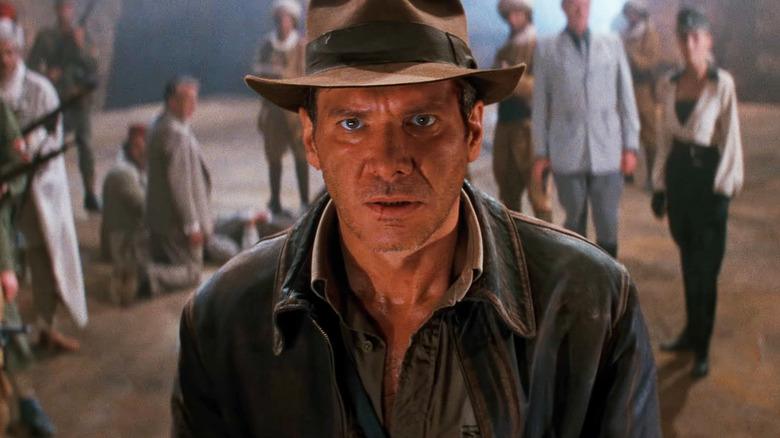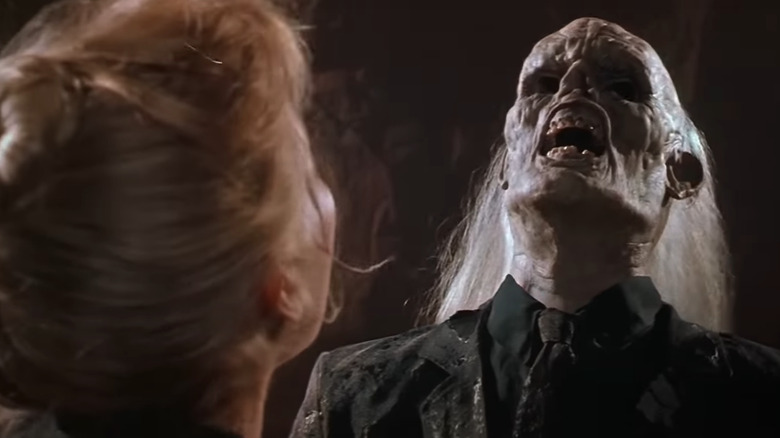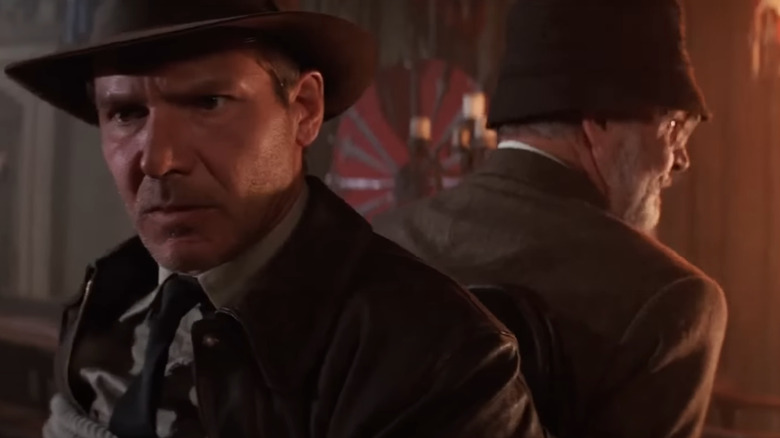Indiana Jones And The Last Crusade Made Good Use Of A Simple Styrofoam Cup
With "Indiana Jones and the Last Crusade," Steven Spielberg and George Lucas delved into their characters more than with their previous two Indy efforts. The film is ostensibly centered around the search for the Holy Grail, but is really about a man and his father's search for reconciliation and a bond that has eluded them throughout their relationship. Or, as Spielberg said in a making-of featurette, "the search for the father is the search for the Holy Grail."
Foreshadowing some of what he would later showcase in "The Fabelmans," Spielberg used the third Indiana Jones movie to explore the relationship between a son and a father who seemed more interested in excavating history than building a bond with his child. And while 1981's "Raiders of the Lost Ark" is still the best Indy film, it's arguable that "The Last Crusade" is the most complex and perhaps most moving Indy film.
All of which is great. But Spielberg wasn't just looking to mine the depths of his own experiences of a complicated father/son relationship with "The Last Crusade." He was also trying to make up for "Indiana Jones and the Temple of Doom," which to his mind was a startlingly dark departure from what made Indy great in "Raiders," and remains his least favorite film of the franchise. So, alongside the touching story of a man and his son coming together after years of distance, the third Indiana Jones movie featured a bunch of cool stuff like explosions and face-melting special effects. And wouldn't you believe, something as simple as a styrofoam cup became oddly useful in bringing much of that to life.
Donovan's death
"The Last Crusade" saw Harrison Ford's protagonist and his father, Henry Jones, Sr. (Sean Connery), traveling the globe and getting into all sorts of perilous hijinks in the process, leading to plenty of downright cool moments.
For example, when Julian Glover's deceitful Walter Donovan drinks from the wrong cup during the climax of "The Last Crusade," he rapidly ages and disintegrates before our very eyes, in a moment that recalls the Nazi face-melting greatness from the finale of "Raiders." To create what is arguably one of the coolest moments in Indiana Jones history, the crew at legendary FX studio Industrial Light and Magic had to create some unprecedented practical effects in order to capture the moment in one shot, as per Spielberg's request. That included using two latex heads placed atop a motion controlled rig. But, as a making-of article on TheRaider.net notes, it was the third fake head where things got really interesting.
For this third iteration, makeup effects supervisor Stephan Dupuis recalled how the team used a gray skull as the basis for the fully decayed version of the film's villain. He went on:
"Over [the skull] I needed material that would shrivel up under heat like saran wrap. I looked at different materials and finally just took styrofoam cups and melted them in a solvent until I got liquid. Then I painted this liquid on the inside of the mold for the third head. When that dried I had a very thin plastic skin that served as the outside skin on the face."
The makeshift styrofoam skin made for the perfect effect when heated, shriveling perfectly as planned and creating the effect of Donovan aging into nothingness. But that wasn't the only time styrofoam came in handy on "The Last Crusade."
Styrofoam, the unsung hero of this Indy sequel
One of the most entertaining sequences in "The Last Crusade" is when Indy and his father escape from a Nazi castle in Germany. In a sequence full of delightful physical comedy, the pair manage to flee the castle amid a raging conflagration that threatens to consume them along with the historic building. And once again, to help sell the whole thing, styrofoam proved unusually helpful.
As TheRaider.net's report confirmed, sound designer Ben Burtt actually used the sound of friction against a styrofoam cup to create a suitably impressive soundscape for the fire itself. Burtt is said to have "multiplied the sound at different frequencies with a computer," in order to get the effect he needed, with the sound designer extolling the "digital process of manipulating sounds, stretching them, shrinking them, or changing the pitch."
And if that wasn't enough unexpected styrofoam usage for you, a version of the bridge in the film's famous "leap of faith" scene, which completes the climactic three challenges sequence, was also carved out of green styrofoam. Which, when considered alongside the other ingenious usages of the material in "The Last Crusade," points to a whole untold history of how styrofoam made filmmaking possible in the days before pervasive CGI. It's also a reminder that while Steven Spielberg was interested in telling his father/son story, he also made sure not to get too lost in it, filling his third Indy movie with the kind of thrilling practical effects that had helped make the franchise so memorable in the first place.


